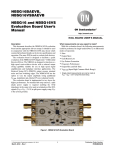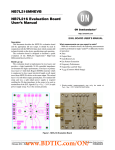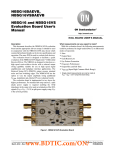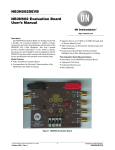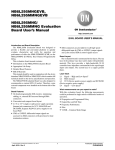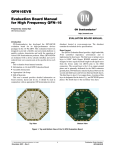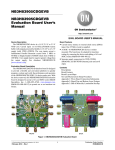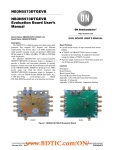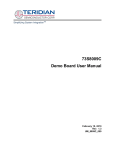Download EVBUM2070 - NB4L339MNGEVB Evaluation Board User`s Manual
Transcript
NB4L339MNGEVB NB4L339MNGEVB Evaluation Board User's Manual http://onsemi.com EVAL BOARD USER’S MANUAL INTRODUCTION AND BOARD DESCRIPTION Layer Stack ON Semiconductor has developed an evaluation board for the NB4L339 Clock Generator as a convenience for customers interested in performing their own device engineering assessment. The board offers a flexible and convenient platform to quickly evaluate, characterize and verify the performance and operation of the NB4L339. This evaluation board manual contains: • Information on the NB4L339 Evaluation Board • Appropriate Lab Setup • Detailed Board Features • Bill of Materials This manual should be used in conjunction with the device datasheet (www.onsemi.com/pub/Collateral/NB4L339.PDF), which contains full technical details on the device specification and operation. The NB4L339 Evaluation Board was designed to accommodate a custom QFN−32 socket. Therefore, some external components were installed on the bottom side of the board. SMA connectors are provided for all input & output signal access. L1 Signal L2 SMA Ground L3 VCC (positive power supply) and VEE (Device negative power supply) L4 Signal Board Features • Incorporates on−board slide switches to manually • • • control CLKSEL, DIVSEL, EN and MR logic pins, minimizing cabling 2.5 V or 3.3 V single or split−power supply operation LVPECL differential output signals are accessed via SMA connectors Convenient and compact board layout What Measurements Can You Expect to Make? With this evaluation board, the following measurements could be performed in single ended or differential modes of operation. • Jitter • Output Skew • Eye Pattern Generation • Frequency Performance • Output Rise and Fall Time • Phase Noise Board Layout The evaluation board is constructed with FR4 material, provides a high bandwidth 50 W controlled trace impedance environment and is designed to minimize noise and minimize crosstalk. www.BDTIC.com/ON/ © Semiconductor Components Industries, LLC, 2012 February, 2012 − Rev. 1 1 Publication Order Number: EVBUM2070/D NB4L339MNGEVB Top View Bottom View Figure 1. NB4L339MNGEVB Evaluation Board Lab Setup for Time Domain Measurements Table 1. Basic Lab Equipment Description Example Equipment Qty Power Supply with 4 outputs HP6624A 1 Oscilloscope and/or Frequency counter TDS8000 with 80E01 Sampling Head 1 Differential Signal Generator Agilent 8133A, Advantest D3186 1 Matched High Speed Cables with SMA Connectors Storm, Semflex 6 Pair Digital Voltmeter, Power supply cables Lab Setup 1. SMAGND (VTT) is the termination supply for the LVPECL outputs only, not to be confused with the device ground pin (VEE). A typical lab setup for taking time domain measurements in differential mode operation is shown in Figure 2. The following steps should be followed for proper equipment setup: Step 2: Connect Inputs For Differential Mode: Connect the differential output of the signal generator to the differential input of the device (CLKx and CLKx). The differential clock inputs of the NB4L339 incorporate internal 50 W termination resistors. For Single−Ended Mode: Connect the single−ended output of the generator to the CLKx input of the device. Vth must be applied to the complementary input (CLKx) when operating in single−ended mode. Refer to the device datasheet for details on single−ended operation. The VTA and VTB termination pins each have a trace from package pin to a node where it can be connected to either VCC, VEE or SMAGND, depending on the user’s need. NOTE: Inputs CLKA/B and CLKA/CLKB must be signal driven or auto oscillation may result. Step 1: Connect Power Three power levels must be provided to the board, VCC, VEE, and SMAGND via the banana jack connectors on the bottom of the board. Bypass capacitors are installed from VCC to SMAGND and VEE to SMAGND at the banana jacks and the deivce pins. Using the split power supply mode, GND = VTT = VCC − 2.0 V. The exposed pad of the QFN−32 package is connected to VEE. Table 2. NB4L339 Power Supply Connections 3.3 V Setup VCC = 2.0 V VCC = 2.0 V VTT = SMAGND = 0 V VEE = −1.3 V 2.5 V Setup VTT = SMAGND = 0 V VEE = −0.5 V www.BDTIC.com/ON/ http://onsemi.com 2 NB4L339MNGEVB Slide Switches VEE = −1.3 V or −0.5 V +1.3 V or +0.5 V SMAGND (VTT) = 0 V CLK Power Supply Signal Generator CLK VEE VCC = 2.0 V MR Digital Oscilliscope or Frequency Counter SMAGND (VTT) CLKx Q CLKx Q CLKSEL Trigger +2.0 V DIVSEL EN VCC Trigger Figure 2. NB4L339 Board Setup Time Domain (Differential Mode) NOTE: All differential cable pairs must be matched. For single−ended operation, CLKx needs to be tied to VTT through the internal 50 W resistor. sampling head must have internal 50 W termination to ground. NOTE: When single−ended output is being used, the unconnected output for the pair must be terminated to VTT through a 50 W resistor for best operation. Unused outputs pairs may be left unconnected. Since VTT = 0 V, a standard 50 W SMA termination is recommended. Step 3: Setup Input Signals Set the signal generator output amplitude to 500 mV. Set the generator output for a square wave clock signal with a 50% duty cycle. Step 4: Connect Output Signals Step 5: Set CLKSEL, DIVSEL, EN and MR The LVPECL Qxn and Qxn outputs have standard, open emitter outputs and must be externally DC loaded and AC terminated. A split power supply technique takes advantage of terminating the LVPECL outputs into 50 W of an oscilloscope or a frequency counter. Since VTT = VCC − 2 V, offsetting VCC to +2.0 V yields VTT = 0 V or Ground (SMAGND). The VTT terminal connects to the isolated SMAGND connector ground plane, and is not to be confused with the device ground pin (VEE). Connect the Q and Q outputs of the device to the oscilloscope with matched cables. The oscilloscope The CLKSEL, DIVSEL, EN and MR control pins can be controlled from an external source via the appropriate SMA connector, or using the slide switches located on the board, as indicated in Figure 2. In order to use the slide switches, the jumpers/shunts on the bottom side of the board must be installed. When using an external source, remove the jumper for that pin. Refer to the NB4L339 datasheet for details on the proper settings for these pins. www.BDTIC.com/ON/ http://onsemi.com 3 NB4L339MNGEVB Figure 3. Frequency Division with the NB4L339 www.BDTIC.com/ON/ http://onsemi.com 4 NB4L339MNGEVB Figure 4. Evaluation Board Schematic www.BDTIC.com/ON/ http://onsemi.com 5 NB4L339MNGEVB Table 3. Detailed board features by device pin. Pin Name Feature 11, 12, 13, 14, 17, 18, 19, 20, 27, 28, 29, 30 Qxn, Qxn All of the Qxn & Qxn LVPECL outputs have equal length 50 W impedance board traces with SMA connectors. Matched cables can connect to an oscilloscope or frequency counter. 9, 16, 25, 32 VCC The VCC pins are all connected directly to the VCC power plane. Bypass capacitors are installed at each pin. 2, 4, 5, 7 CLKx, CLKx The CLKx & CLKx Clock input pins have equal length board traces with SMA connectors. Matched cables can connect to a signal generator. Resistors R1−R4 are intended to terminate a signal generator with 50 W to ground, if needed. They have been (should be) removed since the NB4L339 already provides internal 50 W termination resistors for a signal generator when VTx is connected to SMAGND in a split−power supply configuration. 3, 6 VTA, VTB 10, 31, 15, 26 CLKSEL, DIVSEL, EN, MR The VTA and VTB pins each have a trace from package pin to a node where it can be connected to either VCC, VEE or SMAGND, depending on the user’s need. Slide Switch Control The board incorporates slide switches to manually control the logic levels for the CLKSEL, DIVSEL, EN and MR control pins, thus, minimizing cabling. In order to use the slide switches, the jumpers/shunts on the bottom side of the board must be installed. External Control The CLKSEL, DIVSEL, EN and MR control pins can be controlled from an external source via the appropriate SMA connector. A 50 W resistor is installed from the trace to SMAGND to terminate a signal generator, if needed. When using an external source, remove the switch jumper/shunt from the bottom of the board. −− EP The exposed pad of the QFN−32 package is connected to VEE. 2. NOTE. x = A, B, C, or D; n = 0 or 1 www.BDTIC.com/ON/ http://onsemi.com 6 NB4L339MNGEVB Table 4. Bill of Materials Comp Manufact Description Part Number Qty Web Site SMA Connector Johnson SMA Connector, Side Launch, Gold Plated 142−0711−821 24 www.johnsoncomponents.com Banana Jack Deltron Red Connector Single PCB Socket 571−0500 1 www.deltron−emcon.com Banana Jack Deltron Black Connector Single PCB Socket 571−0100 2 www.deltron−emcon.com Capacitor AVX Corporation Cap Cerm .1uF 10% 16V X7R 0603 0603YC104KAT2A 8 www.avxcorp.com Capacitor Kemet Cap Tant 22uF 16V 10% SMD T491D2236K016AT 2 www.kemet.com Sliding Switch ITT/Cannon SP3T OS103011MS8QP1 4 www.ittcannon.com Jumper Sullins Electronics HDR jumper shun .1CTR STC02SYAN 4 www.sullinselectronics.com Jumper Sullins Electronics 2−pin jumper PEC36ACN 4 www.sullinselectronics.com Resistor Yageo America Resistor 49.9 Ohm 1/16W 1% 0402 SMD 9C04021A49R9FLMF3 8 www.yageoamerica.com Evaluation Board ON Semiconductor NB4L339 Evaluation Board NB4L339MNGEVB 1 www.onsemi.com Device Samples ON Semiconductor NB4L339 Clock Generator NB4L339MNG 1 www.onsemi.com Nylon Screw Standoff 4 Stand off (Height of Banana Jack) 4 ON Semiconductor and are registered trademarks of Semiconductor Components Industries, LLC (SCILLC). SCILLC reserves the right to make changes without further notice to any products herein. SCILLC makes no warranty, representation or guarantee regarding the suitability of its products for any particular purpose, nor does SCILLC assume any liability arising out of the application or use of any product or circuit, and specifically disclaims any and all liability, including without limitation special, consequential or incidental damages. “Typical” parameters which may be provided in SCILLC data sheets and/or specifications can and do vary in different applications and actual performance may vary over time. All operating parameters, including “Typicals” must be validated for each customer application by customer’s technical experts. SCILLC does not convey any license under its patent rights nor the rights of others. SCILLC products are not designed, intended, or authorized for use as components in systems intended for surgical implant into the body, or other applications intended to support or sustain life, or for any other application in which the failure of the SCILLC product could create a situation where personal injury or death may occur. Should Buyer purchase or use SCILLC products for any such unintended or unauthorized application, Buyer shall indemnify and hold SCILLC and its officers, employees, subsidiaries, affiliates, and distributors harmless against all claims, costs, damages, and expenses, and reasonable attorney fees arising out of, directly or indirectly, any claim of personal injury or death associated with such unintended or unauthorized use, even if such claim alleges that SCILLC was negligent regarding the design or manufacture of the part. SCILLC is an Equal Opportunity/Affirmative Action Employer. This literature is subject to all applicable copyright laws and is not for resale in any manner. PUBLICATION ORDERING INFORMATION LITERATURE FULFILLMENT: Literature Distribution Center for ON Semiconductor P.O. Box 5163, Denver, Colorado 80217 USA Phone: 303−675−2175 or 800−344−3860 Toll Free USA/Canada Fax: 303−675−2176 or 800−344−3867 Toll Free USA/Canada Email: [email protected] N. American Technical Support: 800−282−9855 Toll Free USA/Canada Europe, Middle East and Africa Technical Support: Phone: 421 33 790 2910 Japan Customer Focus Center Phone: 81−3−5817−1050 ON Semiconductor Website: www.onsemi.com Order Literature: http://www.onsemi.com/orderlit For additional information, please contact your local Sales Representative www.BDTIC.com/ON/ http://onsemi.com 7 EVBUM2070/D








